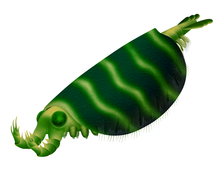|
Deuteropoda
Deuteropoda is a proposed clade of arthropods whose members are distinguished from more basal stem-group arthropods like radiodonts by an anatomical reorganization of the head region, namely the appearance of a differentiated first appendage pair (the 'deutocerebral' pair), a multisegmented head, a hypostome/labrum complex, and by bearing pairs of segmented biramous limbs.[1] The clade contains all living arthropods (i.e. chelicerates and mandibulates) as well as several fossil groups that share these characteristics (e.g. Fuxianhuiida, Megacheira, Isoxyida, and Artiopoda), while excluding other fossil groups that are more 'basal' or 'primitive' (e.g. radiodonts, opabiniids and lobopodians).[1][3] Members of Deuteropoda that are basal to the last common ancestor of chelicerates and mandibulates (and thus lie outside the crown group of Arthropoda) are often referred to as "upper stem group arthropods".[1] Defining characteristicsMembers of Deuteropoda are characterized by the presence of a differentiated labrum and a differentiated first 'deutocerebral' pair of appendages.[1] In contrast, lobopodians (part of the "lower stem group") and onychophorans have a pair of pre-ocular or 'protocerebral' appendages, which presumably have evolved to be the labrum of modern living arthropods.[3] PhylogenyThe cladogram below is a possible panarthropod phylogeny, taking into account the differentiation between "lower stem group arthropods" and "upper stem group arthropods", based on cladograms found in Zeng et al. 2020 and O'Flynn at al. 2022.[4][5] (living groups are marked in bold). Not all parts of this cladogram are widely accepted, as some studies have found Isoxyida, Megacheira, Fuxianhuiida, and/or Artiopoda to lie outside of crown group Arthropoda,[6][7] while some other studies have found a closer relationship to Chelicerata than to Mandibulata for Artiopoda.[7]
References
|
||||||||||||||||||||||||||||







